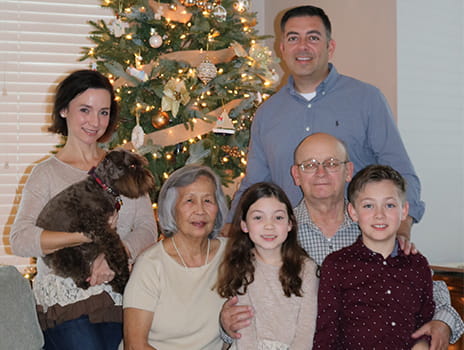- Home
- News Room
- Patient Stories
- New Carotid Stenting Procedure Offers Options to High-Risk Patients
April 03, 2019
Phil Sportsman and his family in front of the Christmas tree.In 1987, Phil Sportsman was 40 years old and serving in the naval reserves. During a regular physical fitness evaluation, Phil’s left leg gave out for no apparent reason.
“I fell, but I wasn’t short of breath,” he recalls. “I was in good shape and assumed there was something wrong with my leg.”
Phil had no idea that vascular disease was the culprit.
“I went to the doctor, and they found a significant blockage in my leg,” he says. A subsequent exam revealed that Phil had suffered a transient ischemic attack (TIA), a temporary blockage of blood flow to the brain. “They checked my carotid arteries and found that my right carotid was badly blocked.”
A history of cardiac procedures increases risk
One of the first procedures in Phil’s now more than 30-year cardiac history was a carotid endarterectomy. The carotid arteries run up each side of the neck, delivering blood to the brain. Waxy plaque that builds up in these arteries can block blood flow and lead to a stroke. Endarterectomy is the standard surgical procedure to clear the blockage. However, in some patients, the carotid plaque rebuilds over time.
Phil was one of these patients. A significant concern is the increased risk of additional endarterectomies.
“For patients who have had surgery, another surgery is possible, but because of scarring, it’s a higher-risk procedure,” explains cardiologist Kamal Gupta, MD, director of the vascular medicine program at The University of Kansas Health System. “There’s a higher risk of nerves becoming damaged because they are entrapped in scar tissue. We prefer to avoid another surgery.”
An alternative is to place a tiny mesh tube called a stent in the artery by threading tiny instruments through an artery in the groin, up through the chest and into the carotid artery. There, the plaque is cleared and the stent implanted to keep the artery open.
“That’s a good procedure, but there is a small risk of stroke,” Dr. Gupta notes. “There’s typically some plaque inside the vessels that we’re going through to reach the carotid, and that plaque can break loose and go to the brain.”
TCAR: A new option for high-risk patients
Fortunately for Phil and other higher-risk patients like him, a new minimally invasive procedure offers a better option. Transcarotid artery revascularization (TCAR) allows surgeons to place a stent – made from specialized wire meshwork – in the carotid artery without having to go through the groin. “In order to perform a TCAR, we make an incision just above the collarbone,” says vascular and endovascular surgeon Axel Thors, DO. Through that incision, Dr. Thors inserts equipment known as the ENROUTE® Transcarotid Neuroprotection and Stent System. “This establishes a sheath, like a straw, that we work through,” he says.
It also connects to an innovative flow-reversal system, he explains. Using this system, blood flows away from the brain during the TCAR procedure, protecting patients from loosened fragments of plaque. The blood runs through a filter and then returns to the body through a second sheath that is placed in the groin. The brain continues to receive blood flow through the opposite carotid artery throughout the procedure.
“It makes it nearly impossible for any debris to go upstream and affect the brain,” Dr. Thors says. “Once we establish that reversal of blood flow, we insert the stent. Then we re-establish normal blood flow.”
Dr. Thors calls the results “profound,” noting there is only a 1.8% stroke risk.
“This is really unheard of in the literature when you look at all the big clinical trials involving carotid stenting,” he says. “The numbers actually beat carotid surgery in many cases. This process provides proactive protection for the patient.”
Phil received TCAR on September 26, 2018. He spent just a single night in the hospital. Phil’s procedure marked the first TCAR procedure performed at the health system and the 9th stent placed in Phil’s arteries since that first episode in 1987. “They’ve really taken excellent care of me,” Phil says. “My doctors at the health system are all just super, and I feel great!”
Phil’s cardiac care team also includes interventional cardiologist Peter Tadros, MD, who oversees and monitors Phil’s ongoing cardiac care.
Dr. Thors says he’s pleased that Phil is doing so well and is optimistic that TCAR will be a strong option for many more patients like Phil.
“We use truly leading-edge technologies to treat advanced carotid disease,” he notes. “The cardiology team here is highly collaborative and always works for the patients’ best care and outcomes.”
Phil credits his physicians and the rest of his cardiac care team for his current ability to enjoy life and focus on the things that matter most – his 2 grandchildren.
“Being a grandpa is my main activity now,” he says. “I’m very lucky and feel really good for an old guy!”





